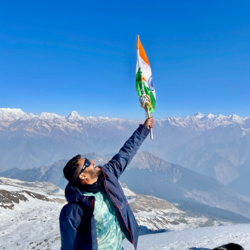If you are new to skiing and are wondering how to attire for your upcoming skiing course, then this article is for you. It lays out the basics of what you will need to keep yourself protected from the cold and the harsh sun.
Ski Socks:
This is unarguably the most indispensable part of your skiing attire. Ski socks are longer than your usual socks and run way above your boots.
Note: Please avoid replacing ski socks with the normal long socks you may use on treks. These are generally shorter than your ski boots.
When you wear socks that are shorter, your boots end up rubbing against your shin through the entire day. The resulting friction causes the skin on your shin to peel and bleed making it difficult to train the next day. We have seen this happen commonly in our Beginners’ Course.
So please ensure you invest in a good pair of skiing socks before your course begins. Look out for material that is quick dry. Some socks even have padding on the shin area.

What to avoid:
Avoid cotton and wool because these can take really long to dry if you get snow into your boots.
Avoid thick socks. Ski boots are generally made to wrap your foot, ankle and shin in a fairly tight hold. Thick socks could make the boots tighter which would restrict blood flow to your feet, leaving them cold.
Ski Pants:
Ski pants, unlike normal pants, have two layers. The layer on the inside that is directly in contact with your skin is known as the snow pant. It is tighter than the outer layer and needs to be pulled over the cuff of your ski boots. Doing this prevents any snow from entering the boots.
The outer layer is generally waterproof/resistant to keep you dry during your ski runs.

Note: Ski pants can be an expensive investment. So, alternatively, you could wear a quick dry or fleece pant on the inside and top it with rain pant (waterproof layer) on the outside.
Ski Jacket
A ski jacket like a ski pant is also made of two layers: an insulation layer underneath and a waterproof layer on the top.
Note: Alternatively, you could also wear a fleece underneath and top it with a rain jacket (waterproof) or a padded jacket (water-resistant). The only downside is these jackets may not arrest your fall/slide down a slope like ski jackets do. But this difference is hardly discernable.
Gloves
Gloves made especially for skiing come with some additional features like built-in wipes for your goggles/sunglasses and longer sleeves that run-up to the middle of your forearm to prevent snow from getting inside.
Note: A usual pair of winter gloves that are waterproof/water-resistant also work for skiing.

Goggles
Since you will be training under harsh sunlight on slopes full of snow on most days, goggles are an absolute necessity to prevent snow-blindness and headaches from the glare of the sun.
Alternatively, polaroid sunglasses also work. Glasses that cover the sides of your eyes that prevent any light from seeping in are ideal. Also, ensure they fit snugly.
You don’t want them coming off every time you fall. To get up on your skis, gather all your belongings every time before resuming your run down the slope can become a cumbersome process.
Neck Gaiter
The winds can get chilly when speeding down the slopes on your skis. A neck gaiter that can be pulled up to cover half of your face would keep you warm and protect you from the sun.
Cap
Carry a warm hat or a cap to protect your head and ears from the cold and the sun.

A Handy Tip
Just like trekking, layering works best for skiing as well. Since training in the Basic Skiing Course, begins early in the morning and progresses through the afternoon well into the evening, you are likely to be experiencing varying temperatures throughout the day.
Wearing layers will allow you to adjust your attire conveniently based on how warm or cold you feel.

Now that you have learnt how to dress for your Basic Skiing Course, it is time to learn How to Wear Your Ski Boots and Skis?






